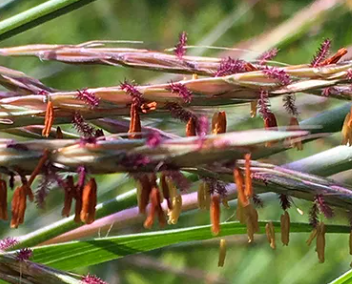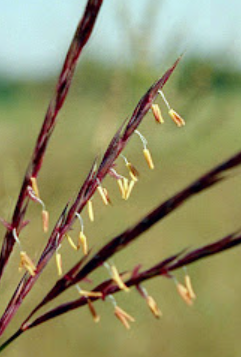Big Bluestem Plant
| Big Bluestem (Andropogon gerardii) grows rapidly to 6 ft, prefers loamy soil, full sun, moderate moisture, and is edible but not medicinal. |

Habit
Grass
Height
1.5-2.5 m
Growth
Moderate
Soil
Well-drained, sandy loam
Shade
Full
Moisture
Moderate
Edible
Yes
Medicinal
No
Origin
North America
Climatic Condition
Temperate
Temperature (°)
15-30°C
Humidity (%)
60-80%
Potting media
Garden soil
Fertilizers
Organic fertilizer
Watering
Regular watering; drought-tolerant once established
Plant Weight
2-4 kg
Flowering Time
Late Summer to Fall
Soil Ph level
6.0 - 7.5
Water Ph level
6.0 - 7.0
Soil EC
0.3 - 0.6
Yield Per Plant
Forage production
NPK ratio
10:10:10
life Span
Perennial
Health Benefits
Used as forage; attracts wildlife.
Suggested Grow Media or Potting Mix ?
50% compost, 25% sand, 25% peat moss
Suggested Fertigation/Fertilizers
Fertilize every 4-6 weeks with balanced fertilizer.
Common Diseases and Remedies
Leaf Spot, Rust, Smut, Root Rot, Anthracnose.
Dark brown spots on leaves, Yellow-orange pustules on leaves, Black, powdery growth on leaves, Yellowing, stunted growth, Dark, sunken lesions on stems.
Copper-based fungicides, Fungicides with propiconazole, Fungicides with mancozeb, Soil-applied fungicides, Fungicides with azoxystrobin.
HEALTH BENEFITS
Health Benefits of Big Bluestem (Andropogon gerardii)
Big Bluestem is a native prairie grass primarily used for soil conservation, livestock forage, and ecosystem restoration. While it is not commonly used in human medicine, some traditional and ecological benefits may indirectly support health and wellness.
1. Rich in Nutrients for Livestock & Soil Health
- Used as nutritious forage for cattle and other grazing animals.
- Helps maintain healthy soil, which supports sustainable agriculture and food security.
2. Environmental & Respiratory Benefits
- Prevents soil erosion, reducing dust pollution that can trigger respiratory issues.
- Helps improve air quality by sequestering carbon and filtering pollutants.
3. Supports Biodiversity & Ecological Balance
- Provides habitat and food for pollinators, birds, and beneficial insects.
- Contributes to a healthier environment, which indirectly supports human well-being.
4. Potential Medicinal & Herbal Uses (Limited Evidence)
- Some Native American traditions may have used grasses like Big Bluestem for herbal poultices or wound healing, but documentation is scarce.
- Similar prairie grasses have been used in traditional medicine for digestive health and fever reduction.
5. Soil & Water Purification
- Absorbs excess nutrients and contaminants from the soil, helping maintain clean water sources.
- Healthy water ecosystems lead to better overall public health.
6. Carbon Sequestration & Climate Health
- Acts as a carbon sink, reducing greenhouse gases and improving air quality.
- A healthier climate contributes to fewer heat-related illnesses and respiratory conditions.
How Big Bluestem Benefits Human Health Indirectly
- Supports sustainable agriculture, ensuring long-term food security.
- Helps combat climate change, reducing pollution-related health risks.
- Contributes to mental well-being through prairie conservation and eco-therapy.

